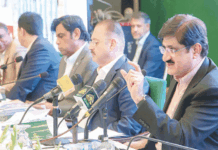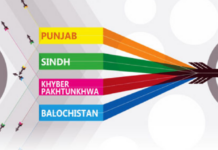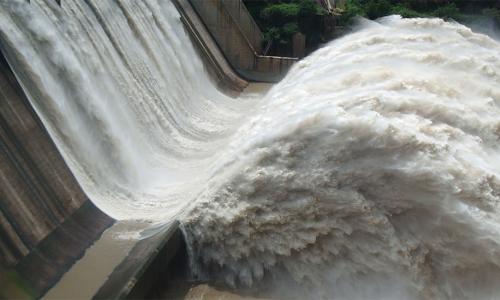India has advanced the start date of four under-construction hydropower projects in the Indian Illegally Occupied Jammu and Kashmir (IIOJK) by several months after suspending a water-sharing treaty with Pakistan that had previously slowed progress, according to an industry source and a government document.
The updated schedule for the projects, which Pakistan generally opposes due to fears of reduced downstream water flow, signals India’s intent to capitalize on its unilateral suspension of the 1960 Indus Waters Treaty. This follows a deadly attack in IIOJK last month.
Indian Prime Minister Narendra Modi’s government has directed authorities to remove obstacles hindering the construction of four hydroelectric projects with a combined capacity of 3,014 megawatts, according to an undated list prepared by the power ministry and reviewed by Reuters.
India has claimed that two of the gunmen responsible for the April 22 attack, which killed 26 people at a tourist site in Occupied Kashmir, came from Pakistan. In response, New Delhi has taken a series of diplomatic and economic measures against Islamabad, further straining already tense relations between the nuclear-armed neighbours.
Islamabad has denied any involvement in the attack and has threatened legal action over the treaty suspension. It has also warned that any attempt to halt or divert water destined for Pakistan would be considered an act of war.
Pakistan relies on the Indus River system for around 80% of its agriculture and the majority of its hydroelectric power generation.
In recent days, the armies of both countries have exchanged small arms fire along the border almost nightly. Pakistani officials warn that India appears to be preparing for a military escalation.
New Delhi has ignored Pakistan’s objections and proceeded with measures that have already disrupted water flows into Pakistan, including maintenance work to increase the holding capacity of two operational hydroelectric plants in IIOJK.
The four hydropower projects now being accelerated are Pakal Dul (1,000 MW), Kiru (624 MW), Kwar (540 MW), and Ratle (850 MW), all located on the Chenab River. Although the Chenab’s waters are allocated primarily to Pakistan under the treaty, India is permitted to construct run-of-river projects that do not involve significant water storage.
India’s state-run NHPC, the largest hydropower developer in the country, is building all four projects. The power ministry document shows that the projects are scheduled to become operational between June 2026 and August 2028. Multiple agencies, including those responsible for law enforcement and labour supply, have been tasked with expediting construction.
Neither NHPC nor the Indian ministries of power, water resources, and foreign affairs responded to requests for comment.
Pakistan’s Indus River System Authority (IRSA) convened a meeting on Monday and expressed unanimous concern over a sudden drop in Chenab River inflows at Marala headworks, attributing the shortfall to Indian restrictions. The authority warned this could lead to additional shortages for the ongoing summer cropping season.
IRSA added that Pakistan’s downstream reservoirs would need to be used strategically to manage the crisis created by reduced Chenab inflows.
India’s water minister declared last month that not a single drop of Indus River water would be allowed to reach Pakistan. According to the Indian industry source, multiple meetings have recently been held between officials from private and government entities and the power ministry to discuss the hydro projects in IIOJK.
“Generally, instructions to fast-track existing projects like this mean that the government wants to plan new ones,” the source said, speaking on condition of anonymity due to the sensitivity of the matter.
India now aims to fast-track a total of seven hydropower projects with a combined capacity of 7 gigawatts, representing an investment of approximately ₹400 billion (around $4.73 billion). Reuters was unable to identify all seven projects.
Pakistan and India are already locked in a legal dispute at the Permanent Court of Arbitration in The Hague over the Ratle project. Pakistan has raised concerns about the project’s pondage (water storage), turbine design, and other technical specifications, alleging they violate the treaty.
Under the original water-sharing agreement, India was required to share detailed information with Pakistan on any project involving the western rivers—the Indus, Chenab, and Jhelum—which are designated for Pakistan’s use.
Modi’s government has sought modifications to the treaty, citing India’s growing population and the need for clean energy sources such as hydropower.
While experts on both sides had previously said India couldn’t immediately cut off water flows due to treaty limitations, a Pakistani official said the flow from the Chenab has already dropped sharply.
Since Sunday, Chenab flows have fallen by 90% from normal levels, according to Muhammad Khalid Idrees Rana, a spokesperson for IRSA. A separate IRSA source confirmed that the river flow at Marala dropped from 31,000 cusecs on Sunday to 3,100 cusecs on Monday, before rising again to 25,000 cusecs.
The official attributed the fluctuations to India’s hydropower activities upstream. “They can do these variations where they stop water and then dump,” the source said. “The magnitude of these variations can’t cause major damage, but they do impact the canals.”























